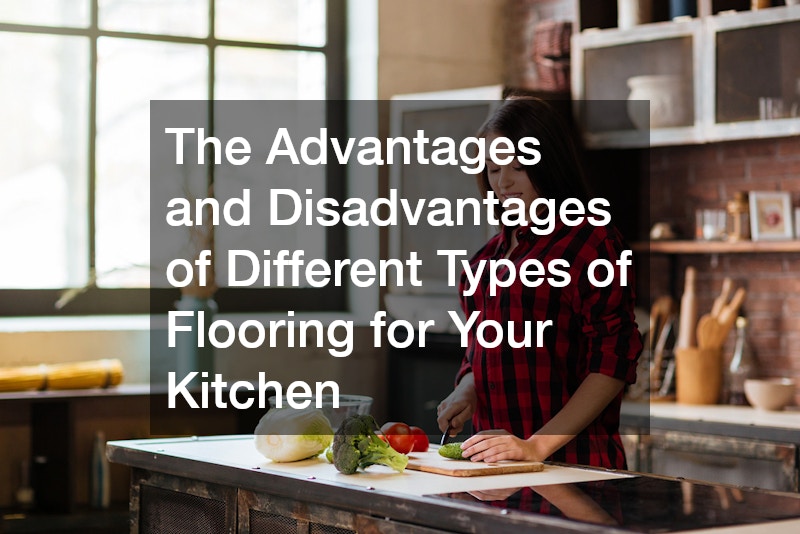Introduction
Selecting the right flooring for your kitchen is essential for creating a functional and visually appealing space. The kitchen floor must handle high traffic, frequent spills, and varying moisture levels while complementing the overall decor of your kitchen. This comprehensive guide explores the pros and cons of several flooring options, ensuring you make an informed decision that aligns with your needs. Understanding the advantages and disadvantages of each type of flooring will help you choose a material that balances durability, style, and maintenance.
When considering flooring options, it is important to evaluate various factors such as durability, aesthetic appeal, maintenance, and cost. Whether you’re working with flooring contractors, exploring options from hardwood companies, or planning a renovation with general contractors, this guide provides insights into popular flooring types. By delving into the specifics of each material, you can make an informed choice that enhances both the functionality and aesthetic of your kitchen.
What Are the Advantages of Ceramic Tile Flooring?

Ceramic tile flooring is a popular choice due to its durability and longevity. This type of flooring can withstand heavy foot traffic, resist stains, and handle occasional spills, making it ideal for the kitchen environment. The durability of ceramic tile means it remains a reliable option for busy areas, and its long lifespan ensures you won’t need to replace it frequently. Additionally, ceramic tiles are available in a wide range of designs and finishes, allowing for significant aesthetic variety. Whether you prefer a modern, sleek look or a more traditional style, ceramic tiles offer numerous options to match your kitchen decor.
Maintenance and cleaning are straightforward with ceramic tile. The non-porous surface of ceramic tiles prevents them from absorbing spills or stains, making them easy to wipe clean. Regular sweeping and mopping are usually sufficient to maintain their appearance. The grout lines between tiles, however, require periodic cleaning and resealing to prevent discoloration and mold growth. Despite this minor upkeep, ceramic tiles generally remain hygienic and easy to maintain. The combination of durability, aesthetic variety, and ease of maintenance makes ceramic tile a strong contender for your kitchen flooring needs.
Are There Any Drawbacks to Using Ceramic Tile?
While ceramic tile flooring has many benefits, there are some drawbacks to consider. One significant issue is the hardness of the tiles, which can make standing for long periods uncomfortable. This hardness can also lead to breakage if heavy objects are dropped, which is a concern in busy kitchens. The installation of ceramic tile often requires the expertise of flooring contractors to ensure a proper fit and to address potential issues like uneven surfaces. This complexity can add to the overall cost of ceramic tile flooring, making it a less budget-friendly option for some homeowners.
Another disadvantage is grout maintenance. Although ceramic tiles are easy to clean, the grout lines between them can become stained or discolored over time. Regular cleaning and occasional resealing of the grout are necessary to maintain its appearance and prevent mold growth. The cost of high-quality ceramic tiles and professional installation can also be higher compared to other flooring options, which might be a concern if you’re working with a tight budget. Evaluating these potential downsides will help you determine if ceramic tile is the right choice for your kitchen.
How Does Hardwood Flooring Perform in a Kitchen?

Hardwood flooring is celebrated for its timeless beauty and the natural warmth it brings to a kitchen. Hardwood companies often highlight the aesthetic appeal of wood, which can complement a variety of kitchen designs from traditional to modern. The natural grains and hues of hardwood create a sophisticated look that can enhance the overall decor of your kitchen. Additionally, hardwood flooring provides a comfortable underfoot experience, which is particularly beneficial for those who spend a lot of time standing in the kitchen.
In addition to its visual appeal, hardwood flooring can increase the value of your home. This value addition is significant, as many potential buyers consider hardwood a desirable feature. The investment in hardwood flooring can be worthwhile for homeowners looking to enhance their kitchen’s functionality and market value. Moreover, with the right care, hardwood flooring can last for many years, making it a durable and attractive option for your kitchen. The combination of aesthetic appeal, comfort, and potential value increase makes hardwood flooring a popular choice for many homeowners.
What Are the Disadvantages of Hardwood Flooring?
Despite its many advantages, hardwood flooring has several notable drawbacks. One major issue is its susceptibility to moisture. Kitchens are prone to spills and high humidity, which can lead to warping or swelling of hardwood planks. Flooring companies often recommend protective measures, such as area rugs or mats, to mitigate these issues, but moisture remains a significant risk factor. This susceptibility to moisture can make hardwood flooring less ideal for kitchens compared to more water-resistant materials.
Maintenance requirements for hardwood flooring can also be demanding. Regular sweeping, mopping, and occasional refinishing are necessary to keep the floor looking its best and to address wear and tear. The cost of hardwood flooring, including both materials and installation, tends to be higher than alternatives like vinyl or laminate. This higher expense, combined with the need for ongoing maintenance, can make hardwood a less practical choice for some homeowners. Additionally, finding the right flooring contractor who specializes in hardwood installation may involve additional costs. Considering these factors will help you decide if hardwood flooring meets your kitchen’s needs.
Is Vinyl Flooring a Good Option for the Kitchen?

Vinyl flooring offers several advantages that make it a practical choice for kitchen environments. One of its most significant benefits is affordability. Vinyl flooring provides a cost-effective option for achieving a stylish look without a substantial investment. This affordability is especially appealing for homeowners working with a budget. Vinyl is also highly water-resistant, making it ideal for kitchens where spills and moisture are common. Its resistance to water helps prevent damage such as warping or staining, ensuring the longevity of the flooring.
Another advantage of vinyl flooring is ease of installation. Many vinyl products come with a click-lock installation system, allowing for straightforward setup that can often be completed by homeowners themselves. This simplicity can save both time and money, reducing the need for professional help. Additionally, vinyl flooring is available in a wide range of styles and designs, including options that mimic more expensive materials like hardwood or stone. This versatility makes vinyl a practical and aesthetically pleasing choice for many kitchen renovations.
What Are the Cons of Using Vinyl Flooring?
Despite its benefits, vinyl flooring has several drawbacks. One concern is its appearance. While vinyl has improved in design, it may not always convincingly replicate the look of higher-end materials such as natural stone or hardwood. This can be a disadvantage for homeowners who prioritize authenticity and luxury in their flooring. Additionally, while vinyl is resistant to moisture, it may be prone to scratches and dents, particularly in high-traffic areas. These scratches can affect the overall look of the flooring over time.
The environmental impact of vinyl flooring is another consideration. Many vinyl products are made from synthetic materials, which may not be the most eco-friendly option. The production and disposal of vinyl flooring can contribute to environmental concerns, making it a less ideal choice for those who prioritize sustainability. Furthermore, although vinyl is relatively durable, it may not match the longevity of higher-end materials. Evaluating these potential drawbacks will help you determine if vinyl flooring is the right choice for your kitchen renovation.
How Does Laminate Flooring Compare?

Laminate flooring is a cost-effective alternative that offers a variety of design options. The cost effectiveness of laminate flooring makes it an attractive choice for homeowners seeking to achieve a stylish look without a significant investment. Laminate products are available in various designs that mimic natural materials like wood or stone, providing flexibility in achieving your desired kitchen decor. This affordability and design versatility make laminate a popular option for many kitchen renovations.
Simplistic installation is another advantage of laminate flooring. Many laminate options feature a click-lock system, allowing for easy and quick installation, often without the need for professional help. This ease of installation can save both time and money, making it a convenient choice for DIY enthusiasts. Additionally, laminate flooring is generally less expensive than alternatives like hardwood or natural stone, offering a budget-friendly solution with a wide range of design choices.
Are There Any Downsides to Laminate Flooring?
Despite its benefits, laminate flooring has some notable drawbacks. One major issue is water resistance. While laminate can handle minor spills, it is not entirely waterproof and may be prone to damage from excessive moisture. In a kitchen setting where spills are frequent, this can be a significant concern. Additionally, laminate flooring may not offer the same level of durability as higher-end materials and can show signs of wear over time. This wear and tear can affect the overall appearance of the flooring.
Repairs and replacement can also be challenging with laminate flooring. When damage occurs, it is often necessary to replace entire planks rather than just the damaged sections, which can be inconvenient and costly. The need for careful maintenance and handling to prevent damage is crucial for preserving the appearance and functionality of laminate flooring. These considerations, along with concerns about water resistance and long-term durability, should be taken into account when evaluating laminate as a flooring option.
What About Natural Stone Flooring?
Natural stone flooring is a luxurious option that adds a unique and timeless aesthetic to any kitchen. The natural aesthetic of stone, including materials like marble, granite, and slate, provides a distinctive look that enhances your kitchen decor. Each type of natural stone has its own unique patterns and colors, contributing to a one-of-a-kind appearance that cannot be replicated by other flooring options. This uniqueness and beauty make natural stone a desirable choice for homeowners looking to create a statement with their kitchen flooring.
Durability is another key advantage of natural stone flooring. Stone is known for its strength and resilience, making it well-suited to handle heavy foot traffic and daily wear. With proper care, natural stone can resist scratches and dents, maintaining its appearance over time. The combination of durability and unique design elements makes natural stone a valuable investment for homeowners looking to enhance the functionality and style of their kitchen. However, it’s important to consult with house remodeling contractors or local flooring contractors to ensure proper installation and maintenance.
What are the Disadvantages of Natural Stone Flooring?
Despite its many advantages, natural stone flooring has several disadvantages. One significant drawback is the high cost associated with both the material and installation. The premium nature of natural stone makes it a considerable investment, which may not fit within every homeowner’s budget. Additionally, the installation process for natural stone can be complex and labor-intensive, often requiring the expertise of renovation builders or local flooring contractors to ensure a proper fit and finish.
Maintenance and sealing are also important considerations for natural stone flooring. To keep the stone looking its best, regular sealing is required to prevent staining and damage. The porous nature of some types of stone means they can absorb spills and become discolored if not properly sealed and maintained. These maintenance requirements, combined with the high initial cost, make natural stone a significant commitment for homeowners. However, with proper care, the unique beauty and durability of natural stone can make it a worthwhile investment. Get a flooring installation today.
Conclusion
Choosing the right flooring for your kitchen involves a careful balance of durability, aesthetics, maintenance, and cost. Each type of flooring—ceramic tile, hardwood, vinyl, laminate, and natural stone—offers distinct advantages and disadvantages. Ceramic tile provides durability and a range of design options but requires grout maintenance and can be hard underfoot. Hardwood adds warmth and value but is susceptible to moisture and demands regular upkeep. Vinyl is affordable and water-resistant but may lack in appearance and durability. Laminate offers cost-effectiveness and ease of installation but struggles with water resistance and longevity. Natural stone provides a unique aesthetic and durability but comes with high costs and maintenance needs.
When making your decision, consider consulting with flooring contractors, hardwood companies, or a kitchen contractor to get professional advice tailored to your specific needs. Whether you are engaging general contractors for a full renovation or working with local flooring contractors for installation, it is important to choose a flooring option that meets your expectations for style, function, and budget. With the right choice, your kitchen floor will not only withstand the demands of daily use but also complement and elevate the overall design of your home. This guide aims to equip you with the knowledge necessary to make an informed decision that enhances both the functionality and beauty of your kitchen.







